 |
Port Louis - The Capital of Mauritius

The capital of the island Mauritius, of which approximately one of each six Mauritian lives, is called Port Louis. If during a dream holiday in Mauritius one sacrifies half a day or a full day for the viewing of the capital of the island is a matter of opinion. Finally, most of the Europeans are on holiday on this island in order to relax from the daily stress and the big city life. But in case of Port Louis there is no way to talk about this. Just the opposite: here, one experiences on a concentrated surface everything what belongs to the big city life: stress, bustle,lots of traffic, waist gas, noise and narrowness.
Port Louis cannot be described in any case as a beautiful city. There are no sightseeings worth to mention in the capital of the island, neither there are some worth while seeing buildings from the colonial period. Therefore, one deeply gets into the daily life of the Mauritians, by having a walk, one finds different cultures with different religions, and still one is repeatedely affected by the people's friendliness.
General Information about Port Louis
Port Louis was founded at the beginning of the 18th century; the city got its name as per the French King Louis XV. The French gouverneur Mahé de Labourdonnais is considered as the foundation father of the city. Port Louis is the capital of Mauritius, from here, the government controls the performance of the island. Port Louis has the biggest port of the island, here, countless ships are loaded and unloaded for the import and the export. The city has nearly 200.000 inhabitants; this means, that approximately on of each six Mauritians live in the capital. For German standards, Port Louis is indeed only a medium sized city, but for a small island this is a real big city.
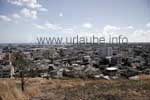
Mauritius is the central traffic junction of the island, and the word junction should be really taken literally. The main traffic road of the island, the highway, runs from Mahébourg in the south-east over Port Louis up to Grand Baie in the north-west. But Port Louis is not avoided, no, the motorway goes across the city. There are practically no possibilities to avoid the capital, and this has also an effect on the traffic. Traffic jamf of a length of several kilometres before an in the city belong to the day order. In the city there is a really thick air; the cars and the numerous buses through huge quantities of waist gas into the air.
And as if the waist gas was not already bad enough, it gets even worse: Port Louis is the hottest city of the whole island. This is on one hand due to the numerous cars and busses, but of course on the other side also due to the natural and artificially arranged incidents. A big surface full of concrete and asphalt heats much more with the sun radiation than a green area with trees and bushes. Additionally, Port Louis is located right at the bottom of a 800 m heighted mountain chain. These mountains do keep the south east winds away from the city, so that in the capital of the island there is calm.
Trip to Port Louis
Although Port Louis is located at the north western part of the island, the capital of Mauritius is easy and quick to access from each spot of the island, as the main communication road of the island leads atraight through the city. Due to this, from practically each of the places of the island, Port Louis is reachable in less than one hour.
The most comfortable way to get to Port Louis is, of course, ba taking a taxi, specially if the car has a working air conditioner. One gets into the car and is taken to the port, from which one starts the city tour. But there is to know that during the week, at least up to 12:00 a.m. the access roads to the capital are totally collapsed. One should straight away calculate half an hour of traffic jam into the taxi drive if one visits the city in the forenoon.

The trip to the capital with the bus is not more comfortable but clearly cheaper. Practically from all spots of the island, a bus drives to the capital of the island. For german standards, the trip is extremely cheap, the travel costs are of approximately one euro, depending on the distance. The bus trip is not comfortable and fast, I would rather describe it as a little adventure. The buses that circulate on the island appear to us as being 50 years old, but there are partly new vehicles built in India simply in the most primitive way. The moise of the motor disables nearly any conversation in the interior, the carriage passes each ground wave mercilessly to the passengers and in the interior, up to five persons are sitting beside each other, and this in a normal bus of a standard width.
In Port Louis gibt there are two big bus termonals, one in the north and one in the south. Here, all buses stop, here, one gets in and out. Te only question is how one finds the right bus among impteem or even hundreds of buses that partly stand around in all directions? No problem, there are numerous position adapters standing around that send one to the right bus; it was really clearly easier than I had expected.
There is a third possibility to be taken to Port Louis and this is by a boat taxi. In this case, the trip to the capital is at the fresh air and one definitely does not get into the traffic jam. But such a ship taxi is not cheap, not to say unpayable, if one comes from the opposite side of the island.
Those who drive with the rented car to Port Louis better park the car in the port area close to the new shopping centre Caudan Waterfront Shopping Complex. It is easy and straight to find from the main road (motorway). I would rather describe it as impossible to find a parking place within the city.
City Tour in Port Louis
We start our city tour of the capital of the island from the nothernbus terminal where most of the buses anyway stop. At only a few steps distance from the Gare du Nord we see a beautiful and gaudy temple to which we pleasantly do a short sidetrip; Entering a temple does not cost anything, but a small donation is expected. One soon notices that the believers put off their shoes, and not only when they step on the colourful marble plates of the temple, but already at the entrance of the temple.
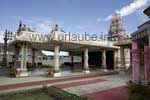
From the bus terminal and/or from the temple we walk a piece into the city, thus away from the sea in direction to the mountains. The orientation in Port Louis is, by the way, very easy, as the inner city is checkered and one has always the sea at one side and the Moka-mountains on the other side as an orientation. At only hundred metres distance from the bus terminal we find the Jummah-mosque. The building built between 1850 and 1890 is the religious centre for the muslim who live in Mauritius. Due to the many ornaments, the exterior of the building rather reminds on an oriental palace than to a chapel. One can also enter this mosque without being a muslim, but then only up to the inner patio from which one has a nice view into the interior of the small palace. At the lower end there is a small fish fountain, at the upper end there is a gorgeous almond tree that apparently was already standing there before the mosque was built.
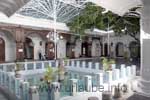
We get out of the mosque and turn our view to the left. A big archway spans the road and makes clear to us what we anyway guessed during our previous march: we are in the chinatown of Port Louis. In fact we do find an abundance of small shops in which the Chinese do offer their products and services. As if we Germans were anyway not impressed by the different cultures of the island, now the Chinese fraction is added. I already mentioned in the beginning that Port Louis is not worthwhile visiting because of its sightseeings but much more because of the interesting living together of numerous cultures in smallest space.
After our short excursion to China, we walk on the Jummah-mosque street further in northern direction into the city centre, where we come across to the main shopping street Sir Seewoosagur Ramgoolam; We turn to the right, thus walk in western direction alongside the street. Here, we find the better shops of the city. We also enter into a multi-level department store that does remind us too much on the well known home country. At the left side of the street there is another big mosque with a big minaret-tower; but contrary to the Jummah-mosque, here is nothing to view.
At the end of our shopping tour in the Ramboolam Street we find the old city theatre that we nearly missed. The beautifil building is much too small compared to the surrounding big buildings. This city theatre has had its time of prosperity long time ago and is only used for some small entertainment shows in the city. But during the boom of the sugar cane trade, the crème de la crème of the European artists act here, as the rich colonial masters could afford to bring the best artists of the world to the island.
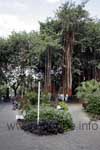
From the city theatre we walk further alongside the street in western direction until we come across to a big church named Immaculée Conception. The church's exterior appears mighty and showy, but the interior is purely and simple. We pass this chruch building more or less by chance, as our actual destination are the Line Barracks, the most western point of our city tour. As visitors, we are only allowed to view only the long wall coverings of the long building chain of the French colonial period, as in the interior there are numerous different police stations where we do not get any permission to enter to.
We walk a little alongside the baracks in direction to the sea and turn at their lower end again to the right, so that we finally come across to the Chaussée Royal. Here, people push through the narrow footways; Numerous mobile merchant do additionally cause some narrowness. One feels like being in a German christmas market, where numerous stands jam the already crowded pedestrian areas. But after some few hundred metres we find a place that for urban standards is a paradisiacal place for relaxing, the Company Garden. In this green oasis amidst the capital we find some huge Banyan-trees and palms that provide a pleasant shade. Here, numerous merchants offer drinks and snacks. We find many local people spending here their lunch break sitting on the park benchs or on the mall walls. It is also for us a pleasant place during our tyring city tour.
Right behind the Company Garden we find the Mauritius Institute, that hides the national library and a natural history museum. This is nothing special for us, we continue walking hundred metres and stand in front of the traffic junction of the city, right in front of the government building. The building that was built in the year 1736 is the oldest conserved building of the city, but it was continuously expanded, so that today we cannot recognize any more its original shape. Today, the actual gorvernment businesses are not concluded in the original building but in neighboured new buildings. We shortly look at the statue of the Queen Victoria, that the English people put into the inner patio after conquering Mauritius, but walk then the wide main traffic road straight away down up to the sea. We nearly asphyxiate by the waist gas, as here, the cars jam in several traks in all directions. It is in fact the traffic junction of the capital; At the left at at the right, we see some bigger banks.
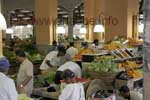
Before we reach the sea, we do a sidetrip to the right in eastern direction. There, there are the famous and notorious market halls of Port Louis. The market halls are without doubt a highlight of Port Louis; here, a lot of people cavort, it is narrow, bustling and noisy. In the halls, one sees repeatedely security people being on patrol, as one i not safe against pickpockets. Thus, the rucksack should in any case be removed from the back and taken to the front side, the money has to be well kept and guarded, so that the day does not end with a bitter disappointment. In the halls, we find some numerous stands, were peasants and merchants offer their goods. From fresh vegetables to fish, meat and herbs up to t-shirts and cloths, we find any kind of imaginable stuff. Unfortunately, one is permanently appealed as a tourist, the merchants are very intrusive, so that soon the wish comes up to leave this place. A quarter of an hour is fully sufficient to gaze at the different nations of inhabitants in these halls, but then straight away out to the fresh air.
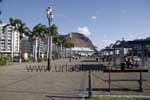
Now, the most exhausting part of our city viewing is over, from now on it will get more calmed and pleasantly. Before we cross over and/or pass under the motorway that goes through the capital, we have a look at the old port office at the sea side. We immediately notice that this building was not built by the French colonists but from the English squad. But now we are finally in the harbour area, where it is more relaxed, calmly and specially more airy. Port Louis has a small but nice boardwalk, where we pleasantly have a small walk and enjoy the views to the side in front of the port basin. We pleasantly sit on one of the numerous park benchs in order to recover a little from the hustle and bustle of the city.
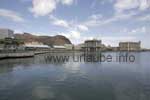
We end our city walk with a visit to a big shopping centre named Caudan Waterfront Shopping Complex. In the interior of this big shopping centre we do not feel any more like being in Mauritius but as being home. In the air conditioned buildings we find some posh shops that sell products of brands that are well known to us. But in between, we also repeatedely find some local products like cloths and small ships. In this shopping centre there are also cinemas, bars, restaurants and fast-food-restaurants. It is simply relaxing to stay here a little before we start our trip back home. From Caudan Waterfront it takes also only ten minutes until we are again at the northern bus terminal and the trip back by bus is not really a relaxing trip...
For our city viewing of the capital Port Louis we spent, including an unhurried lunch break, approximately 5 hours. Including both-way trips, it is soon a whole day excursion. Those who get there by car can do a sidetrip to the surrounding areas as for example to Fort Adélaide or to the Marsfeld. From Fort Adélaide, there is a good general view over the city, but on middays the place is not adequate for taking pictures as there is a strong backlight.
Conclusion: our visit to Port Louis was a really exhausting day tour, but anyway I would not want to miss this trip to the capital of the city, as the city was really worth the visit. Due to the accumulating heat and the extreme air pollution through the abundance of cars and buses I can only recommend to those who wantz to visit the capital to start as early as possible so that a major part of the city viewing takes place during the pleasant morning hours and not during the extremely hot midday hours.

Back to the index Mauritius
Copyright: Patrick Wagner, www.tourist-guide.biz
|
 |